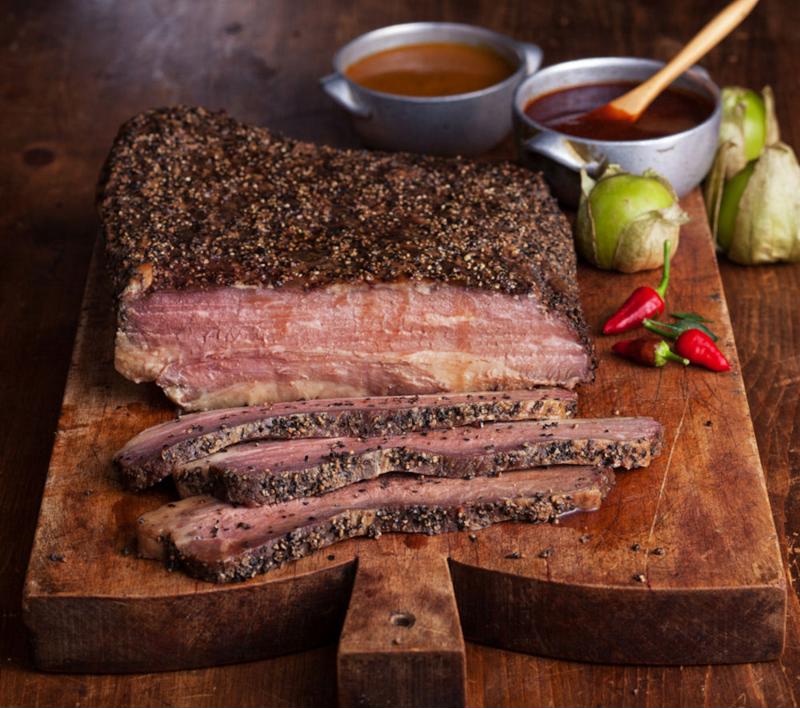Pastrami is one of the most beloved lunch meats in the U.S., served at delicatessens across the country. However, many don’t know how this sandwich favorite is prepared, or what sets truly exceptional pastrami apart.
If you’re taking online cooking courses, you should explore the array of seasonings and the long, complex preparation methods that make the best deli meat. You’ll be able to fully appreciate your next sandwich and also consider how pastrami can provide inspiration for new and exciting recipes of your own.
What makes great pastrami
Pastrami requires an extensive, painstaking process of preparation. The precise flavor combinations are often based on closely guarded house recipes, but it always begins with a piece of beef.
“Pastrami requires an extensive, painstaking process of preparation.”
Some delis may use any cut of brisket for making pastrami, just as they would for corned beef. However, Serious Eats noted that purists emphasize the importance of drawing meat from the cow’s navel. The fattiness of this beef means that it holds up to a lengthy cooking process, producing a tender final product. The cut also allows delis to remain true to a long tradition of taking cheap pieces of meat and making them delicious.
Whatever cut of beef the deli prefers, the first step in preparation is curing. The meat soaks in brine with sugar and often seasonings such as mustard seed and garlic. The precise contents of the brine and length of the curing process differ. For instance, the owners of San Francisco’s Wise Sons Jewish Delicatessen told Fine Cooking that they cure their meat for a week. On the other hand, Katz’s Deli in New York City allows its pastrami to soak for periods ranging between two and four weeks, according to Serious Eats.
The next stage is applying a dry rub to create a spicy crust. The rub generally includes coriander and black pepper, but also other spices such as garlic, onion and mustard seeds. As a rule, delis avoid divulging the contents of the rubs.
Then, the meat is smoked over wood chips at a low temperature for as long as three days. Food writer Michael Ruhlman recommended using a hardwood like maple. This is because hardwoods burn hot and slow, and maple smoke contributes a light, sweet flavor. You might choose oak instead, if you prefer a heavier taste.
The beef finishes cooking either in the oven or by boiling. Finally, it may be placed in a steamer for 15 minutes to a half hour to achieve greater tenderness, as is done at Katz’s. At last, the pastrami is ready to be part of a great sandwich.
 Chefs have developed many tasty applications for pastrami rubs and brine.
Chefs have developed many tasty applications for pastrami rubs and brine.Unique pastrami ideas
There is nothing wrong with a classic pastrami on rye or adding Swiss cheese, sauerkraut and Russian or Thousand Island dressing to make a Reuben. However, some pubs and delis have developed unique, experimental variations on these old standbys. For example, Finnish Top Chef contestant Stefan Richter suggested using Bavarian blue cheese and homemade horseradish sauce to give a pastrami sandwich an exciting twist.
In many establishments, pastrami has been added to hamburgers with extra meaty and thoroughly satisfying results. The New York Times credited Utah-based Crown Burgers with popularizing this hybrid. This burger chain tops a traditional cheeseburger with thinly sliced pastrami, tomatoes, onions, lettuce and dressing.
If you’re interested in moving past the familiar deli meat, rest assured that pastrami rubs and curing methods have been successfully applied to a variety of different dishes. According to Bon Appetit, there is no end to culinary possibilities available by applying these traditional ingredients in unconventional ways. Some unusual uses for pastrami flavors include roast chicken, mushrooms, grilled cheese, popcorn and shrimp.
“If you make your own jar of the peppery rub that gives the meat its flavor, you can pastrami anything and everything when inspiration strikes,” explained associate web editor Elyssa Goldberg.
Russ and Daughters Cafe in New York City is one establishment that has taken this concept to heart. There, you can enjoy pastrami-cured salmon on a pretzel bun with Muenster cheese, sauerkraut, pickle and mustard.
When you explore the unique flavors and tender textures of pastrami, it’s sure to give your recipes a comforting, classic, yet intriguingly tasty twist. Concoct versions of the rub and brine and choose the right smoke, and you may have the start of an excellent new signature dish.



